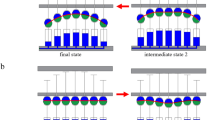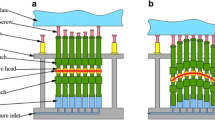Abstract
To solve the problem of springback in traditional multi-point forming (MPF), a new multi-point forming process, namely, multi-point forming with individually controlled force–displacement (MPF-ICFD), is proposed. In this manuscript, traditional MPF and MPF-ICFD are compared. Taking the cylindrical surface as the research object, the change in the springback of a plate is analysed by experiments, and the distribution of the strain and wall thickness of the plate is analysed by numerical simulation. Theoretical analysis is used to calculate the forming window for the MPF-ICFD process, and the results from theoretical analysis are verified by experiments and numerical simulation. The results show that the springback of 1060 aluminium alloy and Q295 for MPF-ICFD can be decreased by 73.8% and 45.5%, respectively, compared with traditional MPF. In traditional MPF, the strain uniformity of the plate is poor, and the maximum thinning rate is 4.5%. For MPF-ICFD, the strain is relatively uniform, and the maximum thinning rate is 0.25%. For an aluminium alloy sheet with a wall thickness of 1.5–3 mm, the upper and lower limits of the forming force for a single head are observed to change linearly from 6.3 to 12.6 kN and from 0.5 to 1 kN, respectively.

















Similar content being viewed by others
Data availability
The datasets used or analysed during the current study are available from the corresponding author on reasonable request.
References
Trzepiecinski T (2020) Recent developments and trends in sheet metal forming. Metals 10(6):779. https://doi.org/10.3390/met10060779
Lee CW, Yu J, Youn HW, Chung Y (2021) The minimum formable radius of subtle feature lines in automotive outer panel stamping. Int J Automot Technol 22(4):993–1001. https://doi.org/10.1007/s12239-021-0089-0
Li Y, Shi ZS, Rong Q, Zhou WB, Lin JG (2019) Effect of pin arrangement on formed shape with sparse multi-point flexible tool for creep age forming. Int J Mach Tools Manuf 140:48–61. https://doi.org/10.1016/j.ijmachtools.2019.03.001
Lee H, Park N, Kim M, Lee MG, Song JH (2022) Recent developments and trends in flexible forming technology. Int J Automot Technol 23(3):741–763. https://doi.org/10.1007/s12239-022-0067-1
Yang DY, Bambach M, Cao J, Duflou JR, Groche P, Kuboki T, Sterzing A, Tekkaya AE, Lee CW (2018) Flexibility in metal forming. CIRP Ann-Manuf Technol 67(2):743–765. https://doi.org/10.1016/j.cirp.2018.05.004
Hwang SY, Lee JH, Yang YS, Yoo MJ (2010) Springback adjustment for multi-point forming of thick plates in shipbuilding. Comput-Aided Des 42(11):1001–1012. https://doi.org/10.1016/j.cad.2010.01.005
Wang H, Zhou J, Zhao TS, Liu LZ, Liang Q (2016) Multiple-iteration springback compensation of tailor welded blanks during stamping forming process. Mater Des 102:247–254. https://doi.org/10.1016/j.matdes.2016.04.032
Liu CG, Li M, Yue T (2021) Springback prediction method for double-curved workpiece considering plate anisotropy in multi-point forming. J Mech Sci Technol 25(6):2623–2636. https://doi.org/10.1007/s12206-021-0533-0
Li FF, Wu JJ, Li Y, Zhang ZK, Wang YA (2016) A new calculating method to perform springback predictions for varied curvature sheet bending based on the B-spline function. Int J Mech Sci 113:71–80. https://doi.org/10.1016/j.ijmecsci.2016.04.013
Zhang QF, Cai ZY, Zhang Y, Li MZ (2013) Springback compensation method for doubly curved plate in multi-point forming. Mater Des 47:377–385. https://doi.org/10.1016/j.matdes.2012.12.005
Zhang ZK, Wu JJ, Zhang S, Wang MZ, Guo RC, Guo SC (2016) A new iterative method for springback control based on theory analysis and displacement adjustment. Int J Mech Sci 105:330–339. https://doi.org/10.1016/j.ijmecsci.2015.11.005
Yoshida F (2022) Description of elastic-plastic stress-strain transition in cyclic plasticity and its effect on springback prediction. Int J Mater Form 15(2):12. https://doi.org/10.1007/s12289-022-01651-1
Panthi SK, Ramakrishnan N, Pathak KK, Chouhan JS (2007) An analysis of springback in sheet metal bending using finite element method (FEM). J Mater Process Technol 186(1–3):120–124. https://doi.org/10.1016/j.jmatprotec.2006.12.026
Xie YM, Huang RY, Tang W, Pan BB, Zhang F (2018) An experimental and numerical investigation on the twist springback of transformation induced plasticity 780 steel based on different hardening models. Int J Precis Eng Man 19(4):513–520. https://doi.org/10.1007/s12541-018-0062-7
Panthi SK, Ramakrishnan N, Ahmed M, Singh SS, Goel MD (2010) Finite element analysis of sheet metal bending process to predict the springback. Mater Des 31(2):657–662. https://doi.org/10.1016/j.matdes.2009.08.022
Esat V, Darendeliler H, Gokler MI (2002) Finite element analysis of springback in bending of aluminium sheets. Mater Des 23(2):223–229. https://doi.org/10.1016/S0261-3069(01)00062-0
Caro LP, Odenberger EL, Schill M, Niklasson F, Akerfeldt P, Oldenburg M (2021) Springback prediction and validation in hot forming of a double-curved component in alloy 718. Int J Mater Form 14(6):1355–1373. https://doi.org/10.1007/s12289-021-01615-x
Ling YE, Lee HP, Cheok BT (2005) Finite element analysis of springback in L-bending of sheet metal. J Mater Process Technol 168(2):296–302. https://doi.org/10.1016/j.jmatprotec.2005.02.236
Chen CD, Liang JC, Teng F, Li Y, Liang C (2021) Research on springback compensation method of 3D flexible stretch bending of multi-point roller dies. Int J Adv Manuf Technol 112(1–2):563–575. https://doi.org/10.1007/s00170-020-06326-2
Zhang Q, Wang ZR, Dean TA (2008) The mechanics of multi-point sandwich forming. Int J Mach Tools Manuf 48(12–13):1495–1503. https://doi.org/10.1016/j.ijmachtools.2008.04.003
Liu W, Chen YZ, Xu YC, Yuan SJ (2016) Evaluation on dimpling and geometrical profile of curved surface shell by hydroforming with reconfigurable multipoint tool. Int J Adv Manuf Technol 86(5–8):2175–2178. https://doi.org/10.1007/s00170-015-8264-y
Jia BB, Wang WW (2017) New process of multi-point forming with individually controlled force-displacement and mechanism of inhibiting springback. Int J Adv Manuf Technol 90(9–12):3801–3810. https://doi.org/10.1007/s00170-016-9709-7
Jia BB, Wang WW (2018) Shape accuracy analysis of multi-point forming process for sheet metal under normal full constrained conditions. Int J Mater Form 11(4):491–501. https://doi.org/10.1007/s12289-017-1359-2
Chu GN, Chen G, Lin YL, Yuan SJ (2019) Tube hydro-forging—a method to manufacture hollow component with varied cross-section perimeters. J Mater Process Technol 265:150–157. https://doi.org/10.1016/j.jmatprotec.2017.11.007
Boudhaouia S, Gahbiche MA, Ayed Y, Giraud E, Salem BW, Santo PD (2018) Experimental and numerical study of a new hybrid process: multi-point incremental forming (MPIF). Int J Mater Form 11(6):815–827. https://doi.org/10.1007/s12289-017-1392-1
Bay N, Olsson DD, Andreasen JL (2008) Lubricant test methods for sheet metal forming. Tribol Int 41(9–10):844–853. https://doi.org/10.1016/j.triboint.2007.11.017
Pourboghrat F, Chu E (1995) Prediction of spring-back and side-wall curl in 2-D draw bending. J Mater Process Technol 50(1–4):361–374. https://doi.org/10.1016/0924-0136(94)01398-K
Mirnia MJ, Vahdani M, Shamsari M (2018) Ductile damage and deformation mechanics in multistage single point incremental forming. Int J Mech Sci 136:396–412. https://doi.org/10.1016/j.ijmecsci.2017.12.051
Funding
This work was supported by Shandong Provincial Natural Science Foundation (No. ZR2020ME145) and 333 High-level Talent Training Project of Jiangsu province (third level, 2022).
Author information
Authors and Affiliations
Contributions
The main processing experiment, conception and design of the study, and the preparation of the original manuscript were performed by BJ. WW was responsible for reviewing and supervising the final version. GC was responsible for editing and revising the manuscript. Measurement experiments and analysis were completed by YS and YG.
Corresponding author
Ethics declarations
Ethics approval
Not applicable.
Consent to participate
All authors have approved to participate.
Consent for publication
The manuscript is approved by all authors for publication.
Competing interests
The authors declare no competing interests.
Additional information
Publisher's note
Springer Nature remains neutral with regard to jurisdictional claims in published maps and institutional affiliations.
Rights and permissions
Springer Nature or its licensor holds exclusive rights to this article under a publishing agreement with the author(s) or other rightsholder(s); author self-archiving of the accepted manuscript version of this article is solely governed by the terms of such publishing agreement and applicable law.
About this article
Cite this article
Jia, BB., Chen, G., Wang, WW. et al. Deformation characteristics and forming force limits of multi-point forming with individually controlled force–displacement. Int J Adv Manuf Technol 123, 1565–1576 (2022). https://doi.org/10.1007/s00170-022-10236-w
Received:
Accepted:
Published:
Issue Date:
DOI: https://doi.org/10.1007/s00170-022-10236-w




